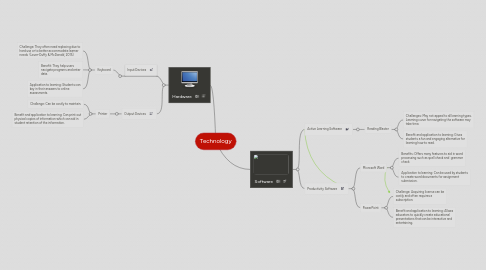
1. Hardware
1.1. Input Devices
1.1.1. Keyboard
1.1.1.1. Challenge: They often need replacing due to hard use or to better accommodate learner needs (Lever-Duffy & McDonald, 2015).
1.1.1.2. Benefit: They help users navigate programs and enter data.
1.1.1.3. Application to learning: Students can key in their answers to online assessments.
1.2. Output Devices
1.2.1. Printer
1.2.1.1. Challenge: Can be costly to maintain.
1.2.1.2. Benefit and application to learning: Can print out physical copies of information which can aid in student retention of the information.
2. Software
2.1. Active Learning Software
2.1.1. Reading Blaster
2.1.1.1. Challenges: May not appeal to all learning types. Learning curve for navigating the software may take time.
2.1.1.2. Benefit and application to learning: Gives students a fun and engaging alternative for learning how to read.
2.2. Productivity Software
2.2.1. Microsoft Word
2.2.1.1. Benefits: Offers many features to aid in word processing such as spell check and grammer check
2.2.1.2. Application to learning: Can be used by students to create word documents for assignment submission.
2.2.2. PowerPoint
2.2.2.1. Challenge: Acquiring license can be costly and often requires a subscription.
2.2.2.2. Benefit and application to learning: Allows educators to quickly create educational presentations that can be interactive and entertaining.
